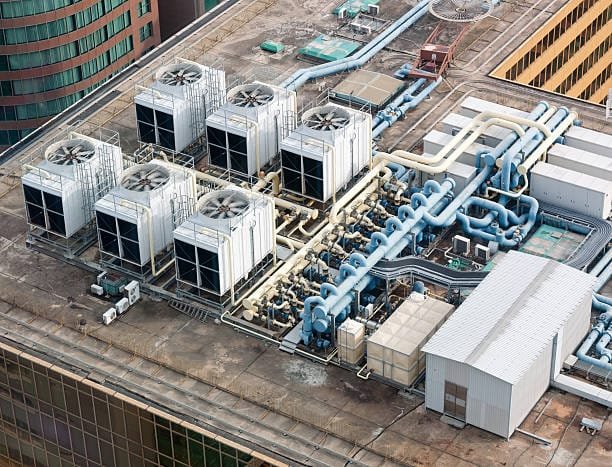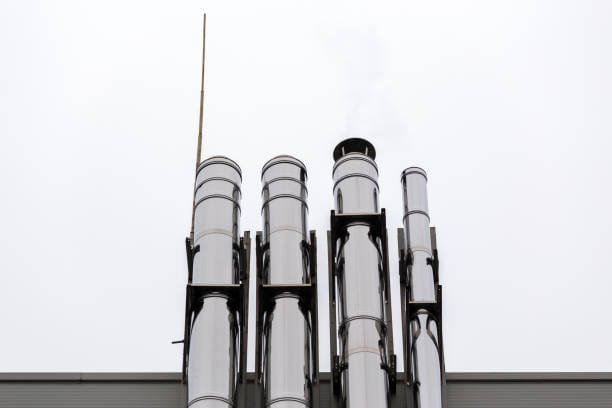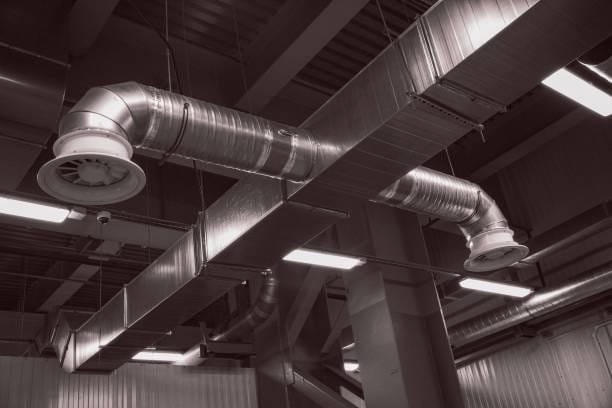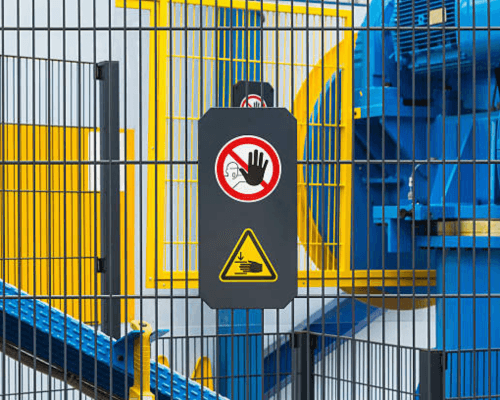
INDUSTRIAL VENTILATION SYSTEMS IN CHENNAI
We are trusted dealers and distributors of industrial ventilation systems in Chennai, providing reliable solutions for clean and safe air. Our products ensure optimal air quality and compliance with industry standards.
What is Industrial Ventilation?
Industrial ventilation refers to systems designed to maintain clean and breathable air in industrial environments. These systems achieve this by removing airborne contaminants such as dust, fumes, and particulate matter while introducing fresh air. Effective industrial ventilation not only improves air quality but also ensures regulatory compliance and enhances overall workplace safety. Typically, industrial ventilation systems operate on two fundamental principles:

AIR EXHAUST SYSTEMS
These remove contaminated air from the workspace, filter harmful particles, and release purified air elsewhere.

AIR SUPPLY SYSTEMS
These introduce clean, filtered air into the workspace, often using HVAC mechanisms to regulate temperature, humidity, and air quality.
Together, these systems create a balanced cycle of air extraction and fresh air circulation, ensuring a safe and comfortable working environment.
Why is Ventilation Important for Industrial Environments?
Industrial ventilation is a critical component of maintaining a safe, efficient, and productive workplace. Unlike residential or commercial spaces, industrial environments often deal with airborne contaminants, high heat, humidity, and odors that can pose risks to both employees and equipment. Here’s why ventilation is essential for industrial settings:
Ensures Health and Safety
• Removes Harmful Contaminants: Industrial processes release pollutants like dust, fumes, and chemical vapors. Prolonged exposure can cause respiratory problems, skin irritation, or even long-term health issues. Ventilation ensures these contaminants are removed efficiently.
• Maintains Air Quality: Proper ventilation circulates fresh air, keeping oxygen levels balanced and preventing suffocation risks in confined spaces.
• Minimizes Fire and Explosion Risks: Accumulated dust and fumes in the air can be highly flammable. Ventilation reduces the concentration of hazardous substances, lowering the risk of accidents.


Protects Equipment and Machinery
• Prevents Dust Build-up: Dust and particulate matter can interfere with machinery, sensors, and electronics, causing malfunctions or breakdowns.
• Reduces Corrosion: Proper ventilation prevents humidity build-up, which can lead to rust and damage to metal components.
• Enhances Longevity: Clean air helps machinery operate efficiently and extends its lifespan by reducing wear and tear caused by contaminants.
Improves Employee Productivity
• Comfortable Working Environment: Proper air circulation helps regulate temperature and humidity, making the workplace more comfortable for employees.
• Reduces Fatigue and Illness: Fresh air prevents heat stress, headaches, and fatigue caused by poor air quality, ensuring employees can focus better and perform efficiently.


Meets Regulatory and Environmental Standards
• Compliance with Safety Regulations: Many industries are required by law to maintain specific air quality standards. Ventilation systems ensure compliance with OSHA and other environmental regulations.
• Eco-Friendly Operations: Ventilation reduces emissions of harmful pollutants into the environment, supporting sustainable practices.
Reduces Costs in the Long Run
• Prevents Downtime: Regular airflow prevents equipment failures and health-related employee absences, minimizing interruptions to operations.
• Energy Efficiency: Advanced ventilation systems consume less energy, helping reduce utility bills while maintaining air quality.

What types of industrial Ventilation
Exhaust Ventilation Systems
Exhaust systems are designed to remove contaminated air from the workplace. These systems use fans, hoods, or ducts to capture harmful substances such as dust, fumes, and vapors, and direct them outside the facility. Exhaust ventilation is essential for areas with high concentrations of airborne pollutants, like welding or chemical processing areas.
Supply Ventilation Systems
Supply ventilation systems introduce clean, filtered air into the workspace. This system typically works by using fans to force fresh air into the building, which is then filtered and conditioned to remove dust, allergens, and pollutants. Supply systems are often used in facilities where a constant influx of clean air is needed to dilute contaminants.
Balanced Ventilation Systems
Balanced ventilation systems combine both supply and exhaust systems to provide a controlled exchange of air. These systems ensure that the air entering and exiting the building is balanced, preventing negative or positive pressure issues. They are highly effective in spaces where both contaminant removal and fresh air intake are needed simultaneously.
Local Exhaust Ventilation(LEV)
Local exhaust systems focus on capturing contaminants at their source, preventing them from dispersing throughout the workplace. These systems include hoods, capture arms, and ducts placed directly near the source of pollution, such as machines or workstations. LEV systems are commonly used in manufacturing, chemical handling, and laboratory environments.
Ducted and Non-Ducted Ventilation Systems
Ducted systems involve extensive ductwork to carry air from one area to another, typically through a filtration or conditioning system. Non-ducted systems, on the other hand, are more localized and direct airflow to a specific area without the use of complex ducts. Ducted systems are typically used in larger industrial setups, while non-ducted systems are ideal for smaller, localized applications.
Air Handling Units (AHUs)
Air handling units (AHUs) are integral to industrial HVAC systems. These systems include fans, filters, heating and cooling coils, and dampers to circulate and condition air before it’s distributed throughout the facility. AHUs are commonly used in large industrial complexes to maintain a consistent, high-quality air supply.
High-Velocity Ventilation Systems
High-velocity ventilation systems use high-speed air jets to rapidly circulate and distribute air throughout the workspace. These systems are particularly effective in environments that require the rapid removal of heat or airborne contaminants, such as large manufacturing plants or assembly lines.
Natural Ventilation Units
Natural ventilation uses the natural movement of outdoor air to ventilate a building. It relies on windows, vents, and building design to allow air to flow through the workspace. While natural ventilation is energy-efficient, it may not always be sufficient for industrial environments with high levels of pollutants or extreme conditions.
Benefits of Industrial Ventilation
Our expertise extends to delivering specialized HVAC systems for various industries:

Safeguard Worker Safety
Industrial dust and airborne contaminants pose significant health risks, even with protective equipment. Effective ventilation systems:
• Remove harmful pollutants.
• Reduce noise pollution caused by aging machinery.
• Promote a safer work environment, decreasing long-term health risks like respiratory issues.

Extend Equipment Lifespan
Accumulated dust can cause serious damage to equipment by:
• Interfering with sensors and circuits.
• Blocking lubricants and jamming mechanical components.
• Increasing the risk of contamination or explosion in high-dust environments.
By removing airborne dust, ventilation systems help protect expensive machinery, reducing repair and replacement costs.

Save Time and Money
While modern ventilation systems require an upfront investment, they:
• Operate more efficiently, reducing energy costs.
• Require less maintenance than outdated systems.
• Minimize downtime caused by equipment failure or poor air quality.
A system assessment can determine the most cost-effective upgrades to improve ventilation and protect your workplace.
Why Choose Us for Industrial Ventilation in Chennai?
At Crystal Air System, we specialize in designing and implementing cutting-edge industrial ventilation systems tailored to your facility’s needs. Our team offers comprehensive services, from system design to installation and ongoing maintenance, ensuring your workplace remains safe, efficient, and cost-effective. Our solutions ensure:

Compliance with safety Standards

Improved air quality and employee productivity

Longevity for your equipment
Frequently Asked Questions?
1. What is the purpose of industrial ventilation?
Industrial ventilation removes harmful contaminants like dust, fumes, and chemical vapors from the air, ensuring a safe and healthy working environment for employees while protecting equipment.
2. Why is ventilation necessary in industrial settings?
Ventilation prevents health risks, improves air quality, reduces the risk of fire or explosion, protects machinery, and ensures compliance with safety regulations.
3. How often should industrial ventilation systems be maintained?
Regular maintenance should be performed at least annually or as recommended by the manufacturer to ensure optimal performance and longevity.
4. Can ventilation systems be customized for specific industries?
Yes, industrial ventilation systems can be tailored to meet the unique needs of industries such as manufacturing, pharmaceuticals, and chemical processing.
5. How does industrial ventilation improve productivity?
By maintaining comfortable air quality and temperature, it reduces employee fatigue, prevents health issues, and ensures smooth equipment operation, boosting overall efficiency.
6. How do I choose the right industrial ventilation system for my facility?
Consult a professional dealer or distributor to assess your facility’s specific requirements, such as airflow, space size, and contaminant type, to recommend the best solution.
Reach Out and Let’s Make Things Happen
Contact us today to discuss your industrial ventilation requirements in Chennai and beyond!
